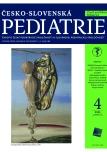Adipose tissue distribution of Czech seven-year-old children according to waist circumference and WHtR – COSI project 2016–2019
Authors:
Metelcová Tereza 1,2; Zamrazilová Hana 1; Procházka Bohuslav 3; Braunerová Taxová Radka 1; Kunešová Marie 1
Authors‘ workplace:
Centrum pro diagnostiku a léčbu obezity, Endokrinologický ústav v Praze
1; 1. lékařská fakulta Univerzity Karlovy, Praha
2; Pediatrická ambulance, Kutná Hora
3
Published in:
Čes-slov Pediat 2023; 78 (4): 220-223.
Category:
Childhood Obesity Epidemic
doi:
https://doi.org/10.55095/CSPediatrie2023/018
Overview
Waist circumference, as a parameter of abdominal obesity, is a major criterion of the metabolic syndrome and is associated with a number of cardiometabolic diseases. WHO Europe organizes surveillance of childhood obesity (COSI = Childhood Obesity Surveillance Initiative), in which the Czech Republic has been participating since the it´s start in years 2007/2008. The aim of this project is to monitor the prevalence of overweight, and obesity, risk waist circumference and environmental factors involved in body weight change.
Waist circumference and waist to height ratio (WHtR) positively correlate with the amount of visceral adipose tissue. In the fifth round in 2019, risk waist circumference was found in 11.37 % of boys and 12.37 % of girls, of which 17.29 % of boys and 7.19 % of girls had BMI < 90.centil (assessed according to Czech reference values). Concurrently, 11.11 % of boys and 13.61 % of girls had increased WHtR, of which 13.85 % of boys and 20.92 % of girls had BMI < 90.percentil.
Therefore, it is important to devote attention to preventive and treatment programs. Due to the relatively high prevalence of subjects with weight BMI < 90.percentil and with a risk waist circumference or risk WHtR the waist circumference measurement may be considered in clinical practice.
Keywords:
obesity – COSI – overweight – children – waist circumference – WHtR
Sources
1. A ldhoon Hainerová I, Zamrazilová H. Zdravotní a psychosociální komplikace obezity u dětí a dospívajících. Pediatr Praxi 2015; 16 : 150–153.
2. A ldhoon Hainerová I, Zamrazilová H. Etiopatogeneze dětské obezity. Ces - -slov Pediat 2019; 74(2): 70–76.
3. F redriksen PM, Skår A, Mamen A. Waist circumference in 6-12-year-old children: The Health Oriented Pedagogical Project (HOPP). Scand J Public Health 2018; 46(21_suppl): 12–20.
4. F ilgueiras MS, Vieira SA, Fonseca PCA, et al. Waist circumference, waist - -to-height ratio and conicity index to evaluate android fat excess in Brazilian children. Public Health Nutr 2019; 22(1): 140–146.
5. A guilar-Morales I, Colin-Ramirez E, Rivera-Mancía S, et al. Performance of waist-to-height ratio, waist circumference, and body mass index in discriminating cardio-metabolic risk factors in a sample of school-aged Mexican children. Nutrients 20181; 10(12): 1850.
6. T randafir LM, Russu G, Moscalu M, et al. Waist circumference a clinical criterion for prediction of cardio-vascular complications in children and adolescences with overweight and obesity. Medicine (Baltimore) 2020; 99(30): e20923.
7. T axová Braunerová R, Kunešová M, Heinen MM, et al. Waist circumference and waist-to-height ratio in 7-year-old children-WHO Childhood Obesity Surveillance Initiative. Obes Rev 2021; 22 Suppl. 6: e13208.
8. S chröder H, Ribas L, Koebnick C, et al. Prevalence of abdominal obesity in Spanish children and adolescents. Do we need waist circumference measurements in pediatric practice? PLoS One 2014; 9(1): e87549.
9. Xi B, Mi J, Zhao M, et al.; Public Health Youth Collaborative and Innovative Study Group of Shandong University. Trends in abdominal obesity among U.S. children and adolescents. Pediatrics 2014; 134(2): e334–9.
10. A rellano-Ruiz P, García-Hermoso A, García-Prieto JC, et al. Predictive ability of waist circumference and waist-to-height ratio for cardiometabolic risk screening among Spanish children. Nutrients 2020; 12(2): 415.
11. Bassali R, Waller JL, Gower B, et al. Utility of waist circumference percentile for risk evaluation in obese children. Int J Pediatr Obes 2010; 5(1): 97–101.
12. S vačina Š. Obezita a kardiovaskulární onemocnění. Postgrad Med 2006; 8 : 50–52.
13. L isá L. Metabolický syndrom v dětství. Ces-slov Pediat 2019; 74(2): 93–97.
14. D avid J, Pešková Š, Toni L, et al. Vážný průběh akutní infekce SARS-CoV-2 u pacientů na Pediatrické klinice Fakultní nemocnice v Motole. Ces-slov Pediat 2022; 77(3): 175–179.
15. Vignerová J, Riedlová J, Bláha P, et al. 2006. 6. celostátní antropologický výzkum dětí a mládeže 2001 Česká republika. Praha: PřF UK v Praze a SZÚ.
16. N agy P, Kovacs E, Moreno LA, et al. IDEFICS consortium. Percentile reference values for anthropometric body composition indices in European children from the IDEFICS study. Int J Obes (Lond) 2014; 38 (Suppl. 2): S15–25.
17. A shwell M, Cole TJ, Dixon AK. Ratio of waist circumference to height is strong predictor of intra-abdominal fat. BMJ 1996; 313(7056): 559–60.
18. R önnecke E, Vogel M, Bussler S, et al. Age - and sex-related percentiles of skinfold thickness, waist and hip circumference, waist-to-hip ratio and waist-to-height ratio: results from a population-based pediatric cohort in Germany (LIFE Child). Obes Facts 2019; 12(1): 25–39.
19. M affeis C, Pietrobelli A, Grezzani A, et al. Waist circumference and cardiovascular risk factors in prepubertal children. Obes Res 2001; 9(3): 179–87.
20. R erksuppaphol S, Rerksuppaphol L. Waist circumference, waist-to-height ratio and body mass index of Thai children: secular changes and updated reference standards. J Clin Diagn Res 2014; 8(11): PC05–9.
21. K unešová M, Procházka B, Taxová Braunerová R, et al. Prevalence nadváhy a obezity u sedmiletých dětí v ČR (COSI ČR), vztah k rozložení tukové tkáně. Ces-slov Pediat 2019; 74(2): 77–80.
Labels
Neonatology Paediatrics General practitioner for children and adolescentsArticle was published in
Czech-Slovak Pediatrics

2023 Issue 4
- What Effect Can Be Expected from Limosilactobacillus reuteri in Mucositis and Peri-Implantitis?
- The Importance of Limosilactobacillus reuteri in Administration to Diabetics with Gingivitis
Most read in this issue
- Periodic fever syndrome, autoinflammatory diseases
- Current trends in the management of inguinal hernia in children
- Spinal muscular atrophy in newborn
- The use of contrast-enhanced ultrasound in diagnosis of liver tumors in newborns
